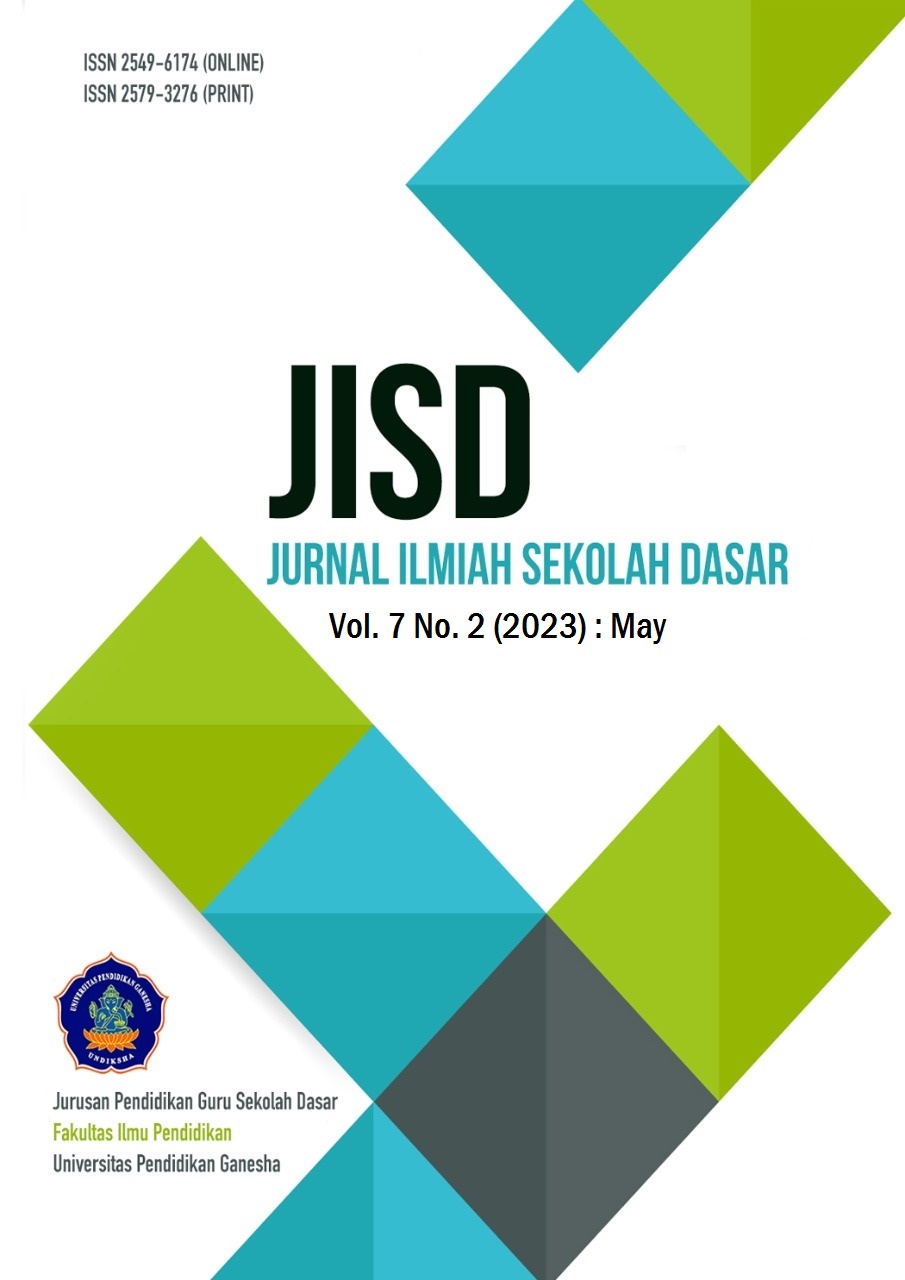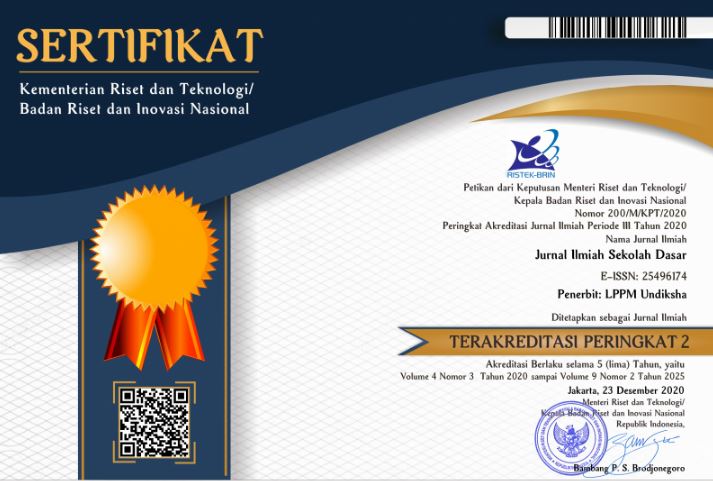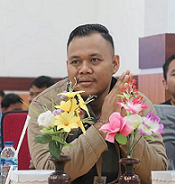Android-Based Interactive Learning Multimedia: Social Studies Material for Fourth Grade Elementary School Students
DOI:
https://doi.org/10.23887/jisd.v7i2.56305Keywords:
Interactive Learning Multimedia, Android, IPSAbstract
Today's learning media have yet to facilitate students' involvement in the learning process fully. This study aims to develop and analyze the effectiveness of Android-based interactive learning multimedia on economic activity material and its relationship to various fields of work and social and cultural life in the environment around elementary school students. The development model used is the Borg and Gall model with 10 development steps. The research subjects used 86 students and 4 grade IV elementary school teachers. The trial was conducted twice, and the operational or effectiveness test used a quasi-experimental design with a nonequivalent control-group design. Data was collected using interviews, questionnaires, scales, and tests. The data analysis technique used is qualitative and quantitative using the T-test. The results of this development research show that the developed Android-based interactive learning multimedia meets the eligibility criteria of "very feasible" with a score of 91 from the material expert and a score of 102 from the media expert, through the results of field trials fulfilling the practicality criteria of "very practical". The t-test analysis results show a significant difference in social studies learning outcomes of students who use Android-based interactive multimedia learning. It was concluded that multimedia based on Android is feasible, practical, and effective for fourth-grade elementary school students' social studies learning.
References
Arifin, S., Wahyudin, W., & Herman, T. (2020). The effects of contextual group guided discovery learning on students’ mathematical understanding and reasoning. Jurnal Prima Edukasia, 8(2), 106–114. https://doi.org/10.21831/jpe.v8i2.33059. DOI: https://doi.org/10.21831/jpe.v8i2.33059
Ayuningtyas, F. B., & Rinawati, W. (2020). The development of interactive android-based learning multimedia on the beef and its processing results course. Journal of Physics: Conference Series, 1446(1). https://doi.org/10.1088/1742-6596/1446/1/012067. DOI: https://doi.org/10.1088/1742-6596/1446/1/012067
Brugar, K. A., & Whitlock, A. M. (2020). Explicit and Implicit Social Studies: Exploring the Integration of Social Studies Experiences in Two Elementary Classrooms. Canadian Social Studies, 51(1), 2–21. https://doi.org/10.29173/css2. DOI: https://doi.org/10.29173/css2
Bulkani, Fatchurahman, M., Adella, H., & Andi Setiawan, M. (2022). Development of animation learning media based on local wisdom to improve student learning outcomes in elementary schools. International Journal of Instruction, 15(1), 55–72. https://doi.org/10.29333/iji.2022.1514a. DOI: https://doi.org/10.29333/iji.2022.1514a
Bulut, R. (2019). An Analysis of The Effects of Multimedia Teaching on Student Achievement. International Journal of Progressive Education, 15(1), 1–22. https://doi.org/10.29329/ijpe.2019.184.1. DOI: https://doi.org/10.29329/ijpe.2019.184.1
Calp, M. H., & Bütüner, R. (2022). Society 5.0: Effective technology for a smart society. Artificial Intelligence and Industry 4.0, Chapter 7, 175–194. https://doi.org/10.1016/B978-0-323-88468-6.00006-1. DOI: https://doi.org/10.1016/B978-0-323-88468-6.00006-1
Choiriyah, Mayuni, I., & Dhieni, N. (2022). The Effectiveness of Multimedia Learning for Distance Education Toward Early Childhood Critical Thinking During the COVID-19 Pandemic. European Journal of Educational Research, 11(3), 1554–1568. https://doi.org/10.12973/eu-jer.11.3.1553. DOI: https://doi.org/10.12973/eu-jer.11.3.1555
Çoruk, H., & Çakır, R. (2017). The effect of multimedia use on academic achievement and anxiety in elementary school student. Turkish Journal of Computer and Mathematics Education (TURCOMAT), 8(1), 1–1. https://doi.org/10.16949/turkbilmat.286655. DOI: https://doi.org/10.16949/turkbilmat.286655
Dhillon, S. S., & Bharti, A. (2022). Blending of ICT: Restruncting of Teacher Education. Shodha Prabha (UGC CARE Journal) Vol., 47(8), 112–126. https://eric.ed.gov/?id=ED619963.
Erlangga, E., Sugiarti, R., Daru, A. F., Desyantoro, I., & Veronika, N. (2022). Si Gabby Application (Student Learning System) to Improve Student’s Learning Achievement in IPS Courses in Learning Activity Studio. Journal of Nonformal Education, 8(1), 32–45. https://doi.org/10.15294/jne.v8i1.345.
Fajrianti, R., & Meilana, S. F. (2022). Pengaruh Penggunaan Media Animaker Terhadap Hasil Belajar Peserta Didik pada Mata Pelajaran IPS Sekolah Dasar. Jurnal Basicedu, 6(4), 6630–6637. https://doi.org/10.31004/basicedu.v6i4.3325. DOI: https://doi.org/10.31004/basicedu.v6i4.3325
Faridah, L., Wiraswati, H. L., Fauziah, N., Aviani, J. K., Robyansyah, R., Ramadan, D. B., & Ekawardhani, S. (2021). Experiences and Challenges of Distance Learning During Covid-19 Pandemic From Educators’ Point of View: A Review. Education Quarterly Reviews, 4(3), 468–483. https://doi.org/10.31014/aior.1993.04.03.354. DOI: https://doi.org/10.31014/aior.1993.04.03.354
Gladden, M. E. (2019). Who will be the members of Society 5.0? Towards an anthropology of technologically posthumanized future societies. Social Sciences, 8(5). https://doi.org/10.3390/socsci8050148. DOI: https://doi.org/10.3390/socsci8050148
Handayani, F., Yulianti, N., & Erita, Y. (2022). Desain Pembelajaran IPS dan PKn Berbasis Teknologi Informasi di Tingkat Sekolah Dasar serta Penggunaan Media Teknologi Informasi dalam Proses Pembelajaran. Jurnal Basicedu, 6(1), 767–781. https://doi.org/10.31004/basicedu.v6i1.2034. DOI: https://doi.org/10.31004/basicedu.v6i1.2034
Handayani, S. L. (2022). ANIMA-LIE: Android-Based Learning Media on Animal Life Cycles Materials for Elementary School. Jurnal Ilmiah Sekolah Dasar, 6(2), 287–294. https://doi.org/10.23887/jisd.v6i2.45359. DOI: https://doi.org/10.23887/jisd.v6i2.45359
Hartley, K., & Andújar, A. (2022). Smartphones and Learning: An Extension of M-Learning or a Distinct Area of Inquiry. Education Sciences, 12(1). https://doi.org/10.3390/educsci12010050. DOI: https://doi.org/10.3390/educsci12010050
Hasanah, F. N., Taurusta, C., Sri Untari, R., Nurul Hidayah, D., & Rindiani, R. (2021). Gim edukasi berbasis android sebagai optimasi pembelajaran daring di masa pandemi Covid 19. JINoP (Jurnal Inovasi Pembelajaran), 7(1), 55–67. https://doi.org/10.22219/jinop.v7i1.15176. DOI: https://doi.org/10.22219/jinop.v7i1.15176
Indah Septiani, A. nisa N. S., Septiani, I., Rejekiningsih, T., Triyanto, & Rusnaini. (2020). Development of interactive multimedia learning courseware to strengthen students’ character. European Journal of Educational Research, 9(3), 1267–1279. https://doi.org/10.12973/eu-jer.9.3.1267. DOI: https://doi.org/10.12973/eu-jer.9.3.1267
Istifci, I., & Ucar, A. D. (2021). A review of research on the use of social media in language teaching and learning. Journal of Educational Technology & Online Learning, 4(3), 475–488. https://doi.org/10.52462/jlls.71. DOI: https://doi.org/10.31681/jetol.922968
Izhar, G., Wardani, K., & Nugraha, N. K. (2022). The Development Enviromental Literacy Media Learning for Elementary School Student. Journal of Innovation in Educational and Cultural Research, 3(3), 397–404. https://doi.org/10.46843/jiecr.v3i3.116. DOI: https://doi.org/10.46843/jiecr.v3i3.116
Juliawan, I. W., Bawa, P. W., & Qondias, D. (2021). Dampak Covid-19 Terhadap Implementasi Pembelajaran Daring Di Sekolah Dasar. Jurnal Ilmiah Pendidikan Citra Bakti, 8(2), 157–169. https://doi.org/10.38048/jipcb.v8i2.342. DOI: https://doi.org/10.38048/jipcb.v8i2.342
Jumriani, Syaharuddin, & Mutiani. (2021). Komponen Kurikulum IPS di Sekolah Dasar pada Kurikulum 2013. Jurnal Basicedu, 5(3), 1120–1129. https://jbasic.org/index.php/basicedu/article/view/896. DOI: https://doi.org/10.31004/basicedu.v5i4.1111
Juniari, N. K., & Margunayasa, I. G. (2022). Android-Based Digital Teaching Materials on the Topic of Changes in the Shape of Elementary School Class V Objects. Jurnal Ilmiah Sekolah Dasar, 6(3), 525–533. https://doi.org/10.23887/jisd.v6i3. DOI: https://doi.org/10.23887/jisd.v6i2.47309
Kadarsih, I., & Fitria, Y. (2022). Implementation of Learning Using Interactive Multimedia Based on Android On Theme 9 be Class V SD. Jurnal Ilmiah Sekolah Dasar, 6(1), 57–65. https://doi.org/dx/10.23887/jisd.v6i1.43470. DOI: https://doi.org/10.23887/jisd.v6i1.41651
Kerssens, N., & Dijck, J. van. (2021). The platformization of primary education in The Netherlands. Learning, Media and Technology, 46(3), 250–263. https://doi.org/10.1080/17439884.2021.1876725. DOI: https://doi.org/10.1080/17439884.2021.1876725
Kristanti, N. N. D., & Sujana, I. W. (2022). Media Pembelajaran Interaktif Berbasis Pembelajaran Kontekstual Muatan IPS pada Materi Kenampakan Alam. Jurnal Penelitian Dan Pengembangan Pendidikan, 6(2), 202–213. https://doi.org/10.23887/jppp.v6i2.46908. DOI: https://doi.org/10.23887/jppp.v6i2.46908
Lao, H. A. E., Tari, E., Nahas, I., Wijaya, H., & Darmawan, I. P. A. (2021). The use of e-learning in motivating students to excel towards learning outcomes. Journal of Education and Learning (EduLearn), 15(3), 458–464. https://doi.org/10.11591/edulearn.v15i3.19368. DOI: https://doi.org/10.11591/edulearn.v15i3.19368
Lasfika, Y. T., Widyastono, H., & Yamtinah, S. (2022). Digitalization Android-based Interactive Learning Media in Geography for High School Students. Journal of Education …, 6(2), 207–216. https://doi.org/10.23887/jet.v 6i2.44674. DOI: https://doi.org/10.23887/jet.v6i2.44674
Lauc, T., Jagodić, G. K., & Bistrović, J. (2020). Effects of Multimedia Instructional Message on Motivation and Academic Performance of Elementary School Students in Croatia. International Journal of Instruction, 13(4), 491–508. https://doi.org/10.29333/iji.2020.13431a. DOI: https://doi.org/10.29333/iji.2020.13431a
Liu, T. C. (2022). A Case Study of the Adaptive Learning Platform in a Taiwanese Elementary School: Precision Education from Teachers’ Perspectives. Education and Information Technologies, 27(5), 6295–6316. https://doi.org/10.1007/s10639-021-10851-2. DOI: https://doi.org/10.1007/s10639-021-10851-2
Nindya, M. I. S., & Dafit, F. (2020). Utilization of Information and Communication Technology for Thematic Learning in Elementary Schools. International Journal of Elementary Education, 6(1), 173–181. https://doi.org/10.2991/assehr.k.200129.101. DOI: https://doi.org/10.2991/assehr.k.200129.101
Ningrum, M. T. A., Purnomo, A., & Idris, I. (2021). Pengembangan media pembelajaran IPS berbasis android materi kerajaan dan peninggalan Hindu-Buddha. JINoP (Jurnal Inovasi Pembelajaran), 7(1), 19–31. https://doi.org/10.22219/jinop.v7i1.14344. DOI: https://doi.org/10.22219/jinop.v7i1.14344
Palavan, Ö. (2021). The Concept of Homeland in Elementary School Students. Education Quarterly Reviews, 4(2), 85–98. https://doi.org/10.31014/aior.1993.04.02.229. DOI: https://doi.org/10.31014/aior.1993.04.02.229
Prachagool, V. (2021). Literature and Project-Based Learning and Learning Outcomes of Young Children. International Education Studies, 14(12), 93. https://doi.org/10.5539/ies.v14n12p93. DOI: https://doi.org/10.5539/ies.v14n12p93
Priyanto, D., & Dharin, A. (2021). Students Creativity Development Model and Its Implementation in Indonesian Islamic Elementary School. Pegem Egitim ve Ogretim Dergisi, 11(3), 81–87. https://doi.org/10.14527/pegegog.2021.00.
Rahmadi, I. F. (2021). Teachers’ Technology Integration and Distance Learning Adoption Amidst the Covid-19 Crisis: a Reflection for the Optimistic Future. Turkish Online Journal of Distance Education, 22(2), 26–41. https://doi.org/10.17718/tojde.906472. DOI: https://doi.org/10.17718/tojde.906472
Rejeki, R., Adnan, M. F., & Siregar, P. S. (2020). Pemanfaatan Media Pembelajaran pada Pembelajaran Tematik Terpadu di Sekolah Dasar. Jurnal Basicedu, 4(2), 337–343. https://doi.org/10.31004/basicedu.v4i2.351. DOI: https://doi.org/10.31004/basicedu.v4i2.351
Sapriya. (2012). Pendidikan IPS Konsep dan Pembelajaran. Rosda Karya.
Sari, P. K., & Mutiara, C. (2022). Cultural Diversity Interactive Multimedia to Improve Cultural Literacy and Citizenship of Elementary School Students. Journal of Innovation in Educational and Cultural Research, 3(3), 333–344. https://doi.org/10.46843/jiecr.v3i3.109. DOI: https://doi.org/10.46843/jiecr.v3i3.109
Sartono, E. K. E., & Wulandari, A. E. (2020). Pengembangan Media Kereta Budaya Untuk Menanamkan Karakter Cinta Tanah Air Siswa Kelas Iv Sd. Kwangsan: Jurnal Teknologi Pendidikan, 8(1), 62. https://doi.org/10.31800/jtp.kw.v8n1.p62--82. DOI: https://doi.org/10.31800/jtp.kw.v8n1.p62--82
Shahzad, M., Nadeem, M. A., & U-Nisa, Z. (2021). Developing Learning Environment Using Interactive Multimedia. Pakistan Journal of Distance & Online Learning, 7(1), 93–106. https://pjdol.aiou.edu.pk/?p=1324.
Siska, Y. (2016). Konsep Dasar IPS. Garudhawaca.
Sugiyono. (2019). Metode Penelitian Pendidikan. Alfabeta.
Suprianti, D., Munzil, M., Hadi, S., & Dasna, I. W. (2021). Guided Inquiry Model Assisted with Interactive Multimedia Influences Science Literacy and Science Learning Outcomes. Jurnal Ilmiah Sekolah Dasar, 5(3), 415. https://doi.org/10.23887/jisd.v5i3.38802. DOI: https://doi.org/10.23887/jisd.v5i3.38802
Surahman, E., & Mukminan. (2017). Peran Guru Ips Sebagai Pendidik Dan Pengajar Dalam Meningkatkan Sikap Sosial dan Tanggung Jawab Sosial Siswa SMP. Harmoni Sosial: Jurnal Pendidikan IPS, 4(1), 1–13. https://doi.org/10.21831/hsjpi.v4i1.8660. DOI: https://doi.org/10.21831/hsjpi.v4i1.8660
Suswandari, M., Siswandari, Sunardi, & Gunarhadi. (2020). Social skills for primary school students: Needs analysis to implement the scientific approach based curriculum. Journal of Social Studies Education Research, 11(1), 153–162. https://www.jsser.org/index.php/jsser/article/view/1980.
Syawaludin, A., Gunarhadi, & Rintayati, P. (2019). Development of augmented reality-based interactive multimedia to improve critical thinking skills in science learning. International Journal of Instruction, 12(4), 331–344. https://doi.org/10.29333/iji.2019.12421a. DOI: https://doi.org/10.29333/iji.2019.12421a
Warman, Suryaningsi, & Mulawarman, W. G. (2021). Overcoming obstacles in implementing 2013 curriculum policy. Cypriot Journal of Educational Sciences, 16(3), 967–980. https://doi.org/10.18844/CJES.V16I3.5770. DOI: https://doi.org/10.18844/cjes.v16i3.5770
Wibowo, D. R. (2021). Problematika Guru SD dalam Pembelajaran IPS Jarak Jauh di Masa Pandemi Covid-19. TERAMPIL: Jurnal Pendidikan Dan Pembelajaran Dasar, 7(2), 167–176. https://doi.org/10.24042/terampil.v7i2.7538. DOI: https://doi.org/10.24042/terampil.v7i2.7538
Wong, R. M., & Adesope, O. O. (2021). Meta-Analysis of Emotional Designs in Multimedia Learning: A Replication and Extension Study. Educational Psychology Review, 33(2), 357–385. https://doi.org/10.1007/s10648-020-09545-x. DOI: https://doi.org/10.1007/s10648-020-09545-x
Yaraş, Z., & Öztürk, F. K. (2022). Society 5.0 in Human Technology Integration: Digital Transformation in Educational Organizations. International Journal of Progressive Education, 18(1), 458–474. https://doi.org/10.29329/ijpe.2022.426.26.
Yuanta, F. (2020). Pengembangan Media Video Pembelajaran Ilmu Pengetahuan Sosial pada Siswa Sekolah Dasar. Trapsila: Jurnal Pendidikan Dasar, 1(02), 91. https://doi.org/10.30742/tpd.v1i02.816. DOI: https://doi.org/10.30742/tpd.v1i02.816
Downloads
Published
How to Cite
Issue
Section
License
Copyright (c) 2023 Gusti Izhar

This work is licensed under a Creative Commons Attribution-ShareAlike 4.0 International License.
Authors who publish with the Journal Ilmiah Sekolah Dasar agree to the following terms:
- Authors retain copyright and grant the journal the right of first publication with the work simultaneously licensed under a Creative Commons Attribution License (CC BY-SA 4.0) that allows others to share the work with an acknowledgment of the work's authorship and initial publication in this journal.
- Authors are able to enter into separate, additional contractual arrangements for the non-exclusive distribution of the journal's published version of the work (e.g., post it to an institutional repository or publish it in a book), with an acknowledgment of its initial publication in this journal.
- Authors are permitted and encouraged to post their work online (e.g., in institutional repositories or on their website) prior to and during the submission process, as it can lead to productive exchanges, as well as earlier and greater citation of published work. (See The Effect of Open Access)










